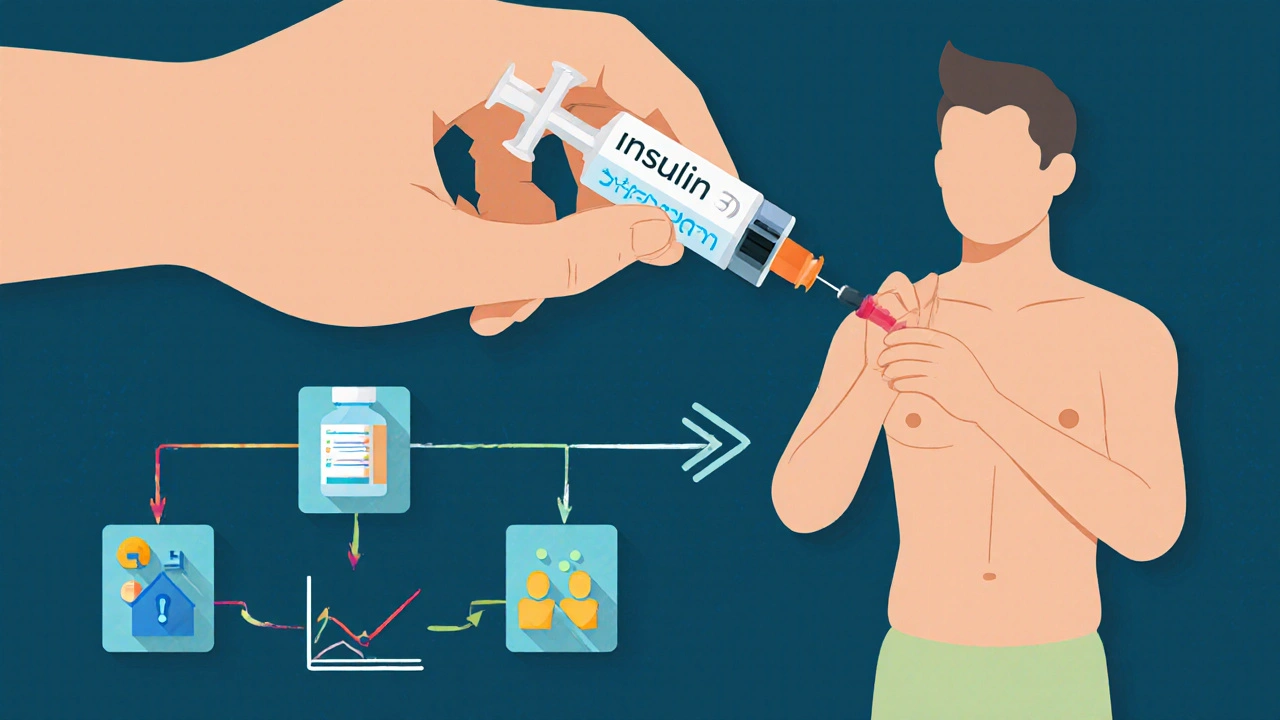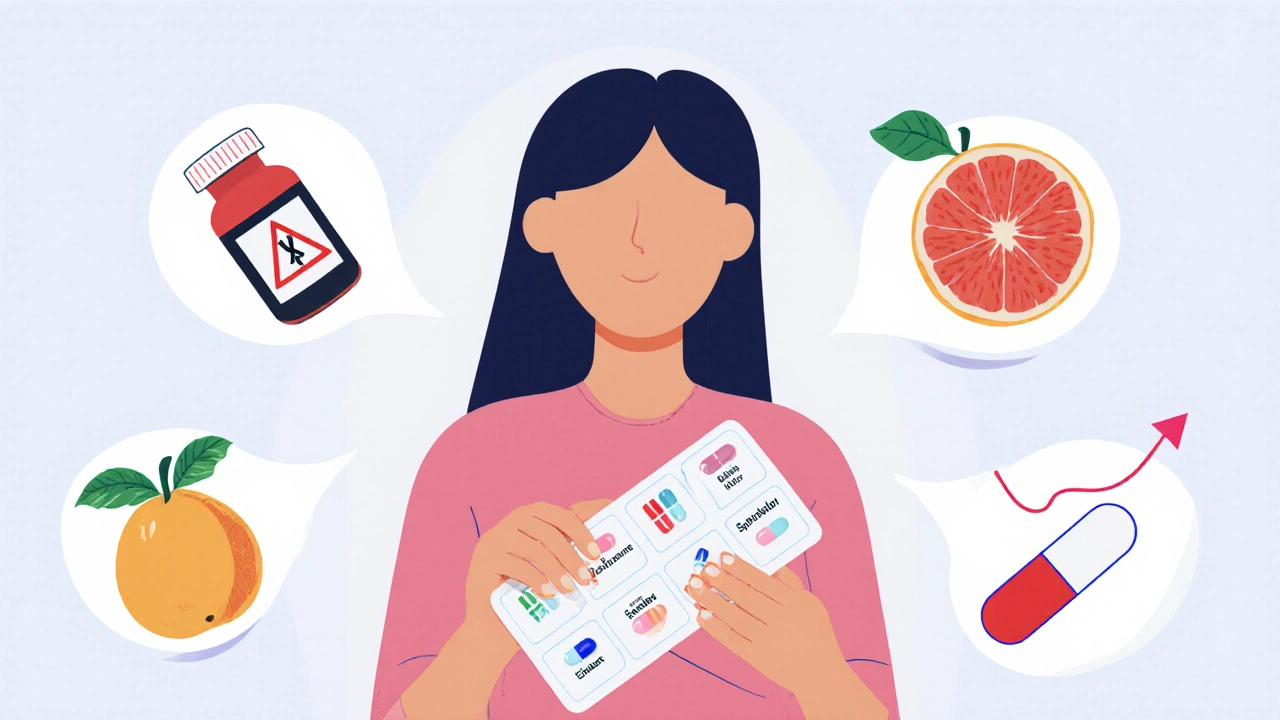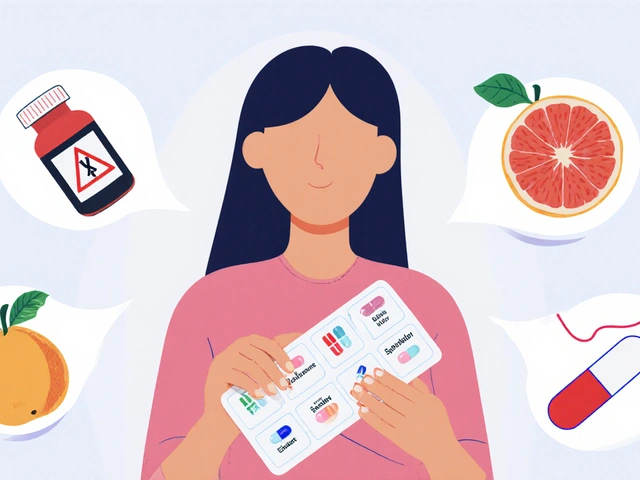When someone starts gender-affirming hormone therapy (GAHT), they’re not just changing their body-they’re starting a long-term medical journey. For transgender women, that often means taking estradiol and an anti-androgen like spironolactone or cyproterone acetate. For transgender men, it’s usually testosterone, given as gel, injection, or pellet. These treatments work. They help people feel more aligned with themselves. But they don’t exist in a vacuum. They interact with other medications-sometimes in ways that aren’t obvious, and sometimes in ways that can be dangerous.
How GAHT Metabolism Creates Interaction Risks
The body breaks down hormones using specific enzyme systems, mainly in the liver. The most important one for GAHT is called CYP3A4. Estradiol, whether taken as pills or patches, relies heavily on this system. If another drug speeds up or slows down CYP3A4, it changes how much estradiol stays in your bloodstream. That can mean your hormone therapy stops working-or you get too much of it, raising your risk of blood clots or other side effects. Testosterone is different. It’s mostly broken down by enzymes called 5-alpha reductase and aromatase. That means it doesn’t interact with CYP3A4 as much. But it still plays nice-or clashes-with other drugs, especially those that affect mood, liver function, or heart health. GnRH agonists like leuprolide are another story. They shut down your body’s natural hormone production. They don’t get metabolized the same way as estrogen or testosterone. That’s why they rarely interact with other medications. But they’re often used at the start of treatment, so knowing how they fit into the bigger picture matters.Antiretroviral Therapy: A Critical Overlap
Transgender people, especially transgender women, are at higher risk for HIV. That means many are on antiretroviral therapy (ART) while also taking GAHT. This overlap is common-and risky if not managed. Some HIV drugs, like efavirenz, are enzyme inducers. They make your liver break down estradiol faster. Studies show this can drop estrogen levels by 30% to 50%. That means you might feel like your hormone therapy isn’t working: mood swings, low libido, or hot flashes return. Your doctor might think you’re noncompliant, when really, your meds are fighting each other. On the flip side, drugs like cobicistat (used in combos like darunavir/cobicistat) are strong inhibitors. They slow down estradiol breakdown. That can cause estrogen levels to spike by 40% to 60% in just two weeks. That’s a red flag for blood clots, stroke, or high blood pressure. If you’re starting a new HIV med, your estradiol dose may need to be lowered-sometimes by half. Good news: integrase inhibitors like dolutegravir don’t interfere much. They might slightly raise estradiol levels, but not enough to worry about. And GnRH agonists? No known interactions with any ART. That makes them a safer option if you’re on complex HIV treatment.PrEP and GAHT: Mostly Safe, But Still Monitor
Pre-exposure prophylaxis (PrEP), like Truvada or Descovy, is vital for HIV prevention. A major 2022 study tracked 172 transgender people on both PrEP and GAHT for 12 weeks. The results were reassuring: hormone levels didn’t change meaningfully. Tenofovir levels (the active part of PrEP) stayed steady too. No dose changes were needed. But here’s the catch: most of that data comes from oral PrEP (TDF/FTC). Long-acting injectable PrEP, like cabotegravir, is newer. There are only two published case reports on its interaction with GAHT. No one knows yet if it affects hormone levels. Until more data comes in, stick with oral PrEP if you’re on estradiol, unless your provider says otherwise.
Psychiatric Medications: The Hidden Conflict
Transgender people experience higher rates of depression, anxiety, and PTSD. Many take SSRIs like fluoxetine or sertraline. Here’s the problem: some of these drugs block CYP2D6, an enzyme that also helps break down estradiol. That means your estrogen levels could rise unexpectedly. You might get breast tenderness, headaches, or nausea-not because your dose is too high, but because your body can’t clear it anymore. Worse, some mood stabilizers do the opposite. Carbamazepine, phenytoin, and rifampin are strong CYP3A4 inducers. They can slash estradiol levels by 30% or more. If you’re on one of these for bipolar disorder or seizures, your hormone therapy might stop working. You might need a higher dose of estradiol-or switch to a different anti-androgen like spironolactone, which is less affected. Testosterone has fewer known interactions with psychiatric meds. But a 2023 review found 17 cases where people on testosterone needed to increase their antidepressant dose by 25% to 50% within six weeks. Why? It’s not fully understood. Maybe testosterone changes brain chemistry in ways that reduce antidepressant effectiveness. Or maybe it improves mood so much that the antidepressant isn’t needed anymore. Either way, watch for changes in mood, energy, or sleep after starting testosterone.Other Common Medications to Watch
You might be on other meds you don’t think are connected. Here’s what to check:- Blood thinners (warfarin): Estradiol can increase clotting factors. If you’re on warfarin, your INR might drop. Your doctor will need to check it more often.
- Insulin or diabetes meds: Testosterone can improve insulin sensitivity, which might lower your blood sugar. You might need less insulin or metformin.
- Thyroid meds: Estradiol increases thyroid-binding proteins. That can make your free T4 levels look low-even if you’re fine. Your doctor should check TSH, not just T4.
- Statins: Some studies suggest testosterone may raise LDL cholesterol. If you’re on a statin, your levels might need closer monitoring.
- Seizure meds: As mentioned, carbamazepine and phenobarbital can interfere with estradiol. Lamotrigine and valproate seem safer.

What Doctors Should Do-And What You Should Ask For
Too many providers still treat GAHT like it’s separate from everything else. It’s not. You need a full medication review before starting, and again every time you add or change a drug. Here’s what to ask:- “Does this new medication interact with my hormones?”
- “Should I get my estradiol or testosterone level checked after starting this?”
- “Is there a safer alternative if this one interferes?”
The Bottom Line: Safety Is Possible-But Not Automatic
Gender-affirming hormone therapy is one of the safest medical treatments out there when properly managed. Serious side effects are rare. But that doesn’t mean you can ignore other meds. The biggest risk isn’t the hormones themselves-it’s the lack of coordination between providers. If you’re on GAHT and take any other prescription, over-the-counter, or herbal product, tell your endocrinologist. Don’t assume they know. Bring a full list. Include supplements, birth control, pain meds, even CBD oil. And if your provider says, “It’s fine,” but you feel off-trust yourself. Ask for a hormone level test. Ask for a second opinion. Your health matters. You deserve care that sees the whole picture, not just one part of you.Can I take birth control pills with feminizing hormone therapy?
No. Birth control pills contain synthetic estrogen (ethinyl estradiol), which is much stronger and riskier than the bioidentical estradiol used in GAHT. Taking both increases your risk of blood clots, stroke, and heart attack without adding any benefit. If you need contraception, use non-hormonal methods like copper IUDs or condoms. Always talk to your provider before combining any hormonal products.
Does testosterone affect mental health medications like SSRIs?
Testosterone doesn’t directly interact with SSRIs like fluoxetine or sertraline. But some people find their antidepressants become less effective after starting testosterone. Studies show about 1 in 10 people need to increase their antidepressant dose by 25-50% within six weeks. This isn’t due to chemistry-it’s likely because testosterone changes brain chemistry or improves mood so much that the original dose is no longer enough. Monitor your mood closely and report changes to your provider.
Are herbal supplements safe with GAHT?
Many herbal supplements interfere with hormone metabolism. St. John’s wort is a strong CYP3A4 inducer-it can cut estradiol levels by up to 50%. Grapefruit juice does the opposite: it blocks CYP3A4 and can raise estrogen dangerously. Even common supplements like ashwagandha or turmeric can affect liver enzymes. Always tell your provider what you’re taking, even if it’s labeled “natural.”
How often should I get my hormone levels checked when starting new meds?
When you start a new medication that could interact with GAHT-like an HIV drug, seizure med, or antidepressant-get your estradiol or testosterone level checked 4 to 6 weeks after starting. That’s when the interaction usually peaks. After that, check every 3 to 6 months if you’re stable. If you feel off-fatigued, moody, or noticing physical changes-get tested sooner. Don’t wait for your next scheduled visit.
Is there a safer type of estrogen if I’m on multiple medications?
Transdermal estradiol (patches or gels) is generally safer than oral forms because it bypasses the liver’s first-pass metabolism. That means fewer interactions with CYP3A4-modulating drugs. If you’re on multiple medications that affect liver enzymes, switching from pills to patches can reduce risks. Ask your provider if this option is right for you.








Ashley Miller November 19, 2025
Of course the pharmaceutical industry loves this stuff - more meds, more profits. Next they’ll tell us estrogen causes your phone to explode. 😏
Sherri Naslund November 20, 2025
so like… if i take st john’s wort and estrogen and then my boyfriend gives me a hug do i turn into a dragon? because that’s what it sounds like. also why does everyone act like this is new? i’ve been on hormones since 2012 and my doc just said ‘eh, you’ll be fine’ and that was it. no blood tests, no nada. now i’m just a walking pharmacy. 🤷♀️
Martin Rodrigue November 21, 2025
While the article provides a clinically relevant overview of pharmacokinetic interactions, it is imperative to recognize that the metabolic pathways of exogenous hormones are not uniformly predictable across populations. Variability in CYP enzyme expression due to genetic polymorphisms, hepatic function, and concomitant medication use necessitates individualized therapeutic monitoring. The assumption that integrase inhibitors are universally benign is not evidence-based in all cases; pharmacogenomic testing should be considered in high-risk cohorts.
Mary Follero November 23, 2025
This is SO important. I’ve seen so many trans folks get dismissed because their doctor didn’t check hormone levels after starting a new med. I’m a nurse and I always tell my patients: if you’re on GAHT and start anything new - even an OTC cold med - get a blood test 4-6 weeks later. Seriously. It’s not paranoid, it’s self-care. You deserve to feel like yourself, not like a lab rat. 💪❤️
Jessica Engelhardt November 23, 2025
Why are we letting Big Pharma dictate how we live? They want you dependent on drugs so they can keep selling them. You don’t need hormone tests. You need to trust your body. Also, why is everyone so obsessed with blood clots? I’ve had three kids and never had one. My estrogen is fine. Stop scaring people. 🇺🇸
Lauren Hale November 25, 2025
Thank you for writing this. I’m a trans woman who’s been on estradiol for 8 years and just started lamotrigine for bipolar. My endo never mentioned the interaction - I had to find it myself. Now I get my levels checked every 3 months. It’s not about fear - it’s about being informed. You’re not alone. And if your provider doesn’t get it, find someone who does. We deserve care that sees the whole person.
Greg Knight November 26, 2025
Look, I get it - meds are confusing. I’ve been on testosterone for 5 years and I still get nervous when I start something new. But here’s the thing: you don’t have to figure this out alone. Write down every pill, patch, herb, and gummy you take. Bring it to your appointment. Ask the questions. Even if your doc looks busy, they’re there to help. And if they don’t? Find a new one. Your health isn’t a backup plan - it’s your priority. You got this.
Hannah Machiorlete November 26, 2025
so like… if i take grapefruit juice and estrogen do i turn into a fairy? also why is everyone acting like this is a crisis? my grandma took birth control in the 70s and lived to 98. also i think this whole thing is just a way to make people feel bad about taking hormones. like, who even cares if your levels go up 10%? you’re still you. 🤷♀️
Kenneth Meyer November 27, 2025
There’s a deeper philosophical question here: when we alter our biology to align with our identity, are we simply correcting a biological misalignment - or are we entering a new domain of human self-creation? The interactions aren’t just chemical; they’re existential. Each pill, each test, each adjustment becomes a ritual of becoming. We are not patients. We are architects of our own embodiment. The system tries to reduce us to lab values - but we are more than our CYP3A4 activity.
Donald Sanchez November 29, 2025
bro i just started testosterone and now my brain feels like a wifi router with 3 bars. also i took ashwagandha because i saw it on tiktok and now my boobs hurt?? why is everything so complicated?? 😭 also why do docs act like we’re aliens?? just give us the info!! 🤪💊
Abdula'aziz Muhammad Nasir November 30, 2025
This is excellent. In Nigeria, many of us struggle to access even basic hormone therapy, let alone proper drug interaction guidance. But when you do get access, this level of detail saves lives. I’ve seen patients on ART and GAHT develop clots because no one checked. Please, providers - listen to your patients. They know their bodies better than any algorithm. We are not statistics. We are people.
Tara Stelluti December 1, 2025
you know what’s really scary? when your doctor says "it’s fine" and then you start bleeding out of nowhere. no one warned me about warfarin. i almost died. now i keep a spreadsheet. every med. every date. every symptom. i’m not paranoid. i’m prepared. and if you’re not doing this? you’re playing russian roulette with your body. 🤕
Danielle Mazur December 3, 2025
Did you know the WHO secretly funded this article? They’re trying to normalize hormone therapy so they can implant tracking chips in our bloodstreams. Why else would they emphasize "therapeutic monitoring"? It’s not about safety - it’s about control. They want you dependent. They want you afraid. Don’t fall for it.
Margaret Wilson December 3, 2025
OMG YES. I switched from pills to patches after reading this and my anxiety dropped by 80%. I was crying in the shower I was so relieved. also i started taking CBD oil (don’t @ me) and my doc didn’t freak out - she just said "cool, let’s check your levels." i feel seen. thank you for writing this. i’m not broken. i’m just… optimized. 💖